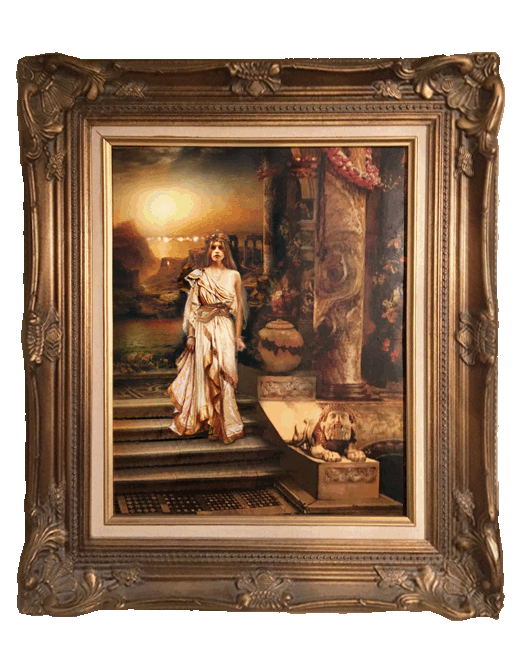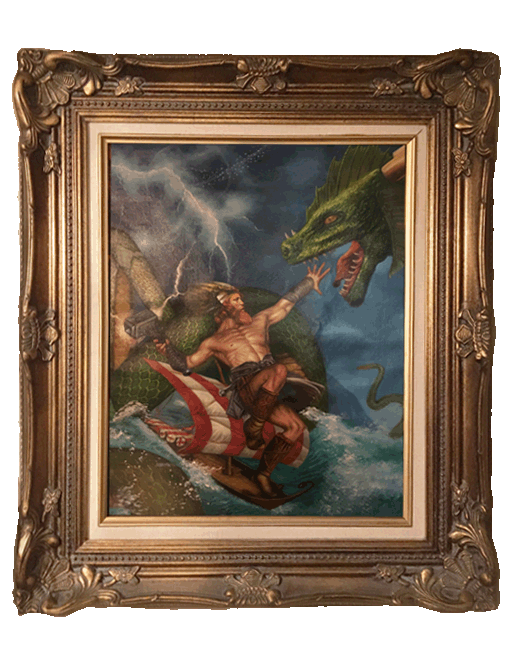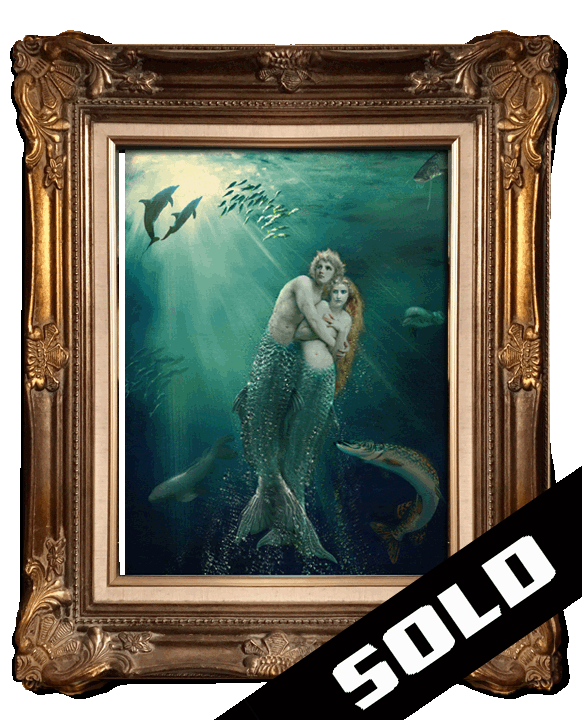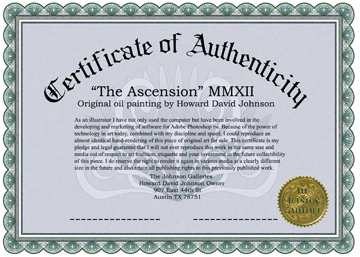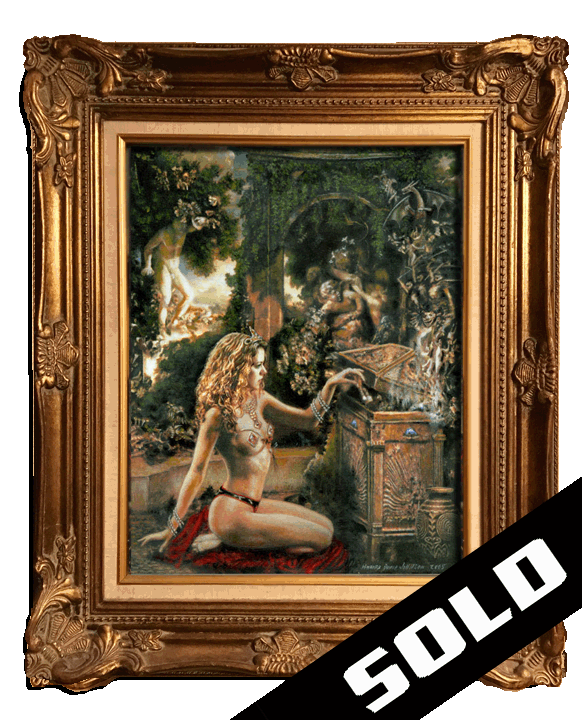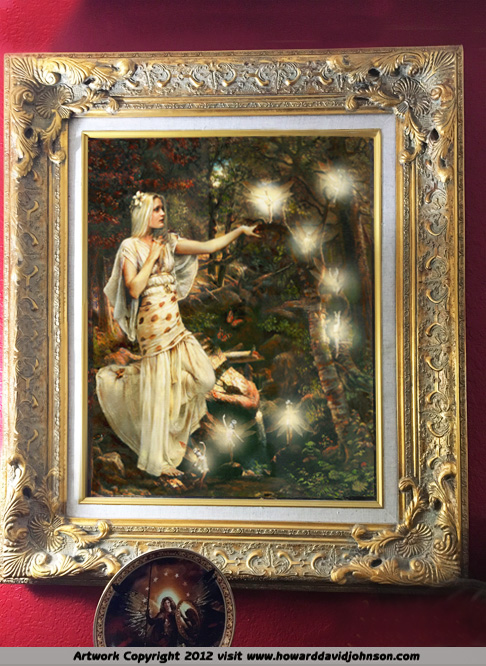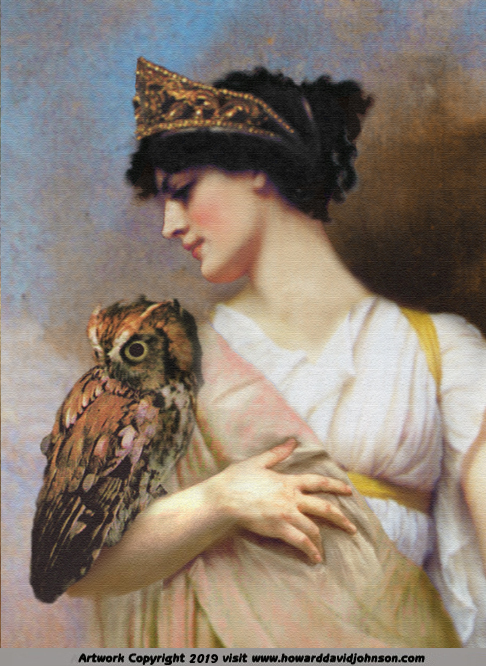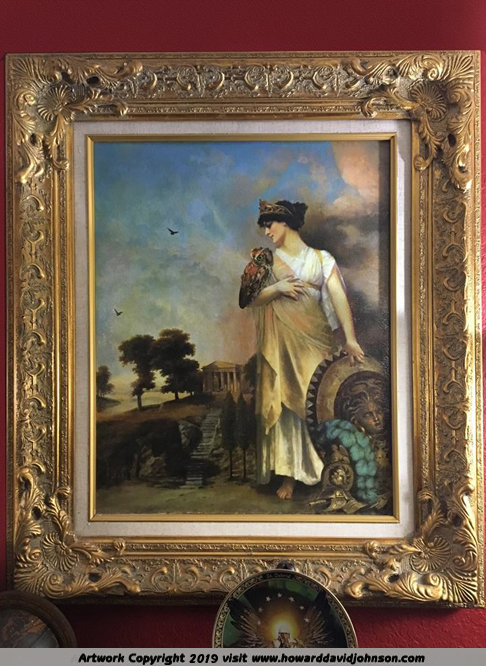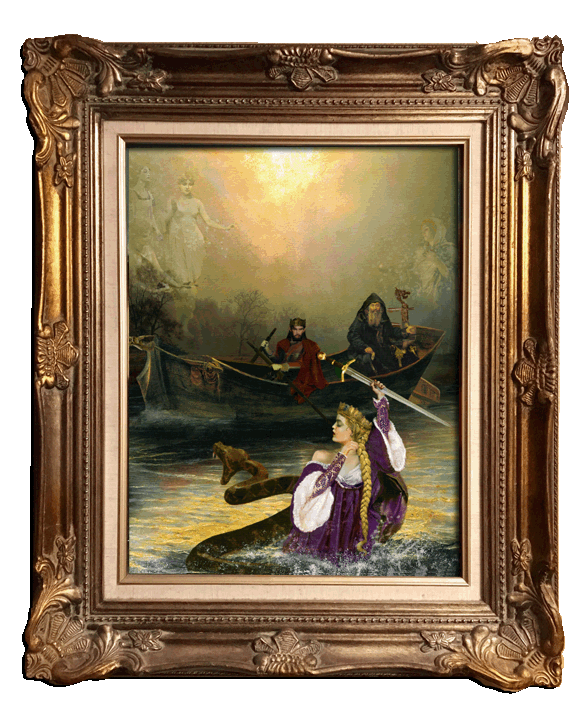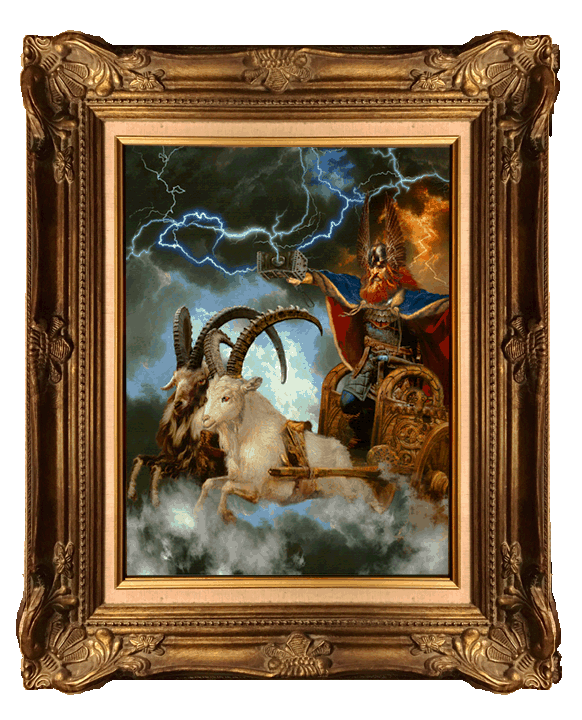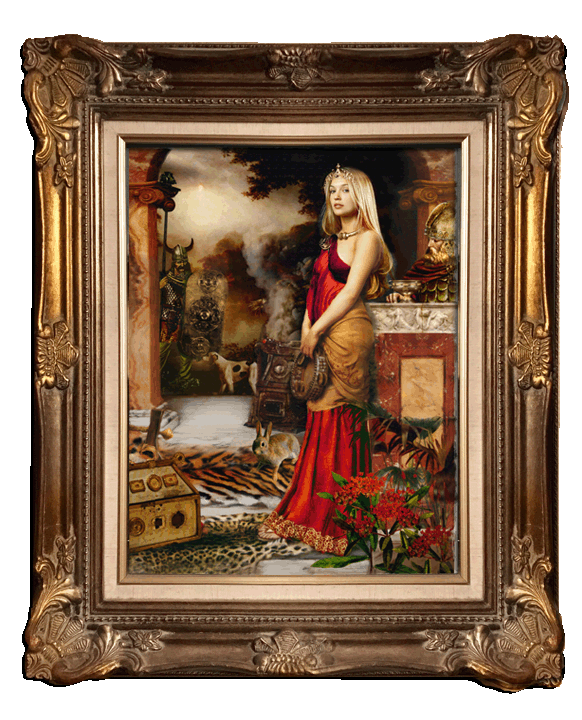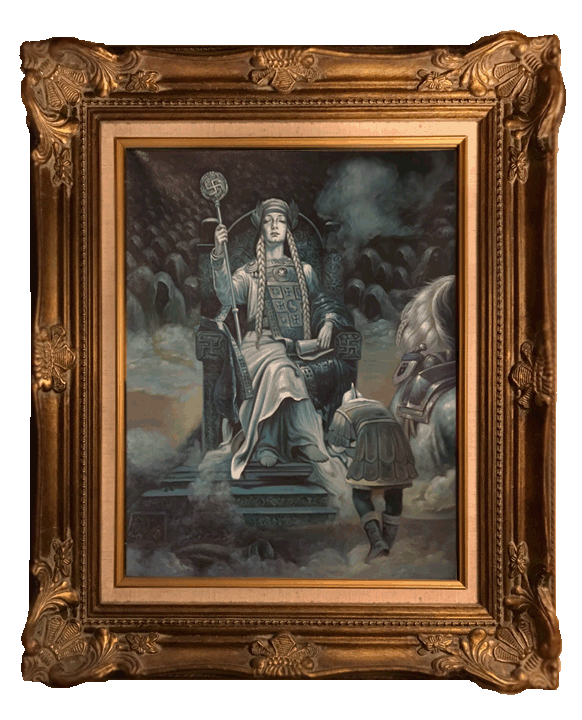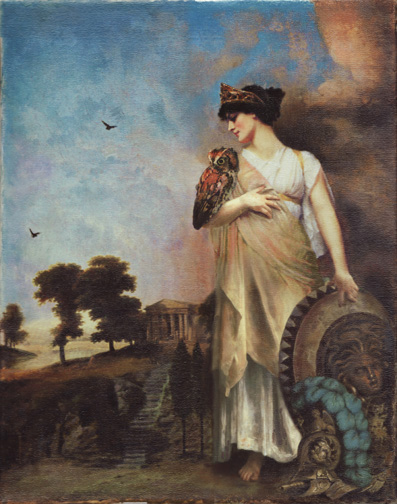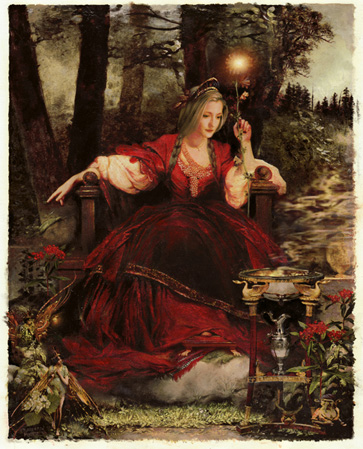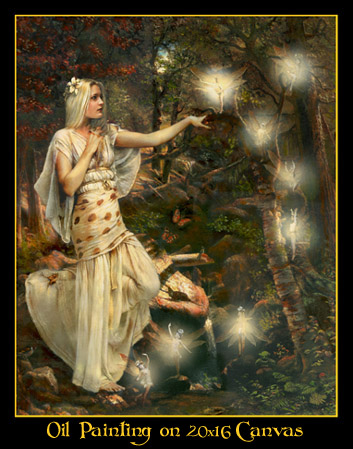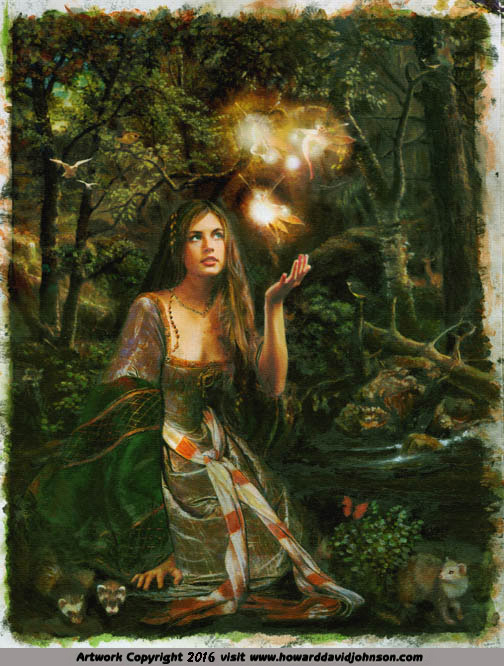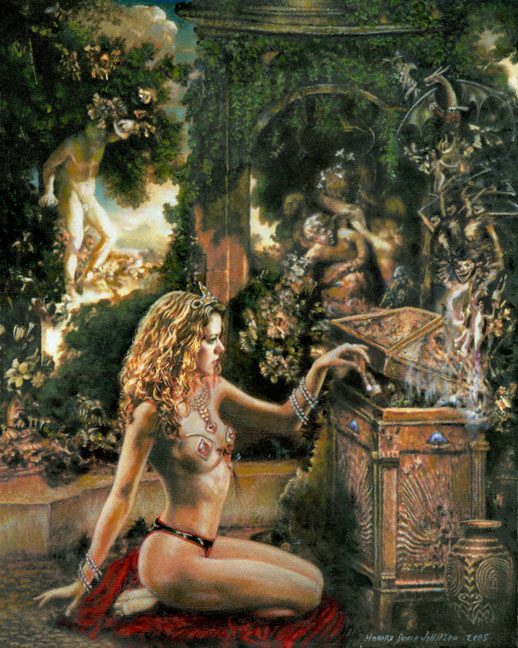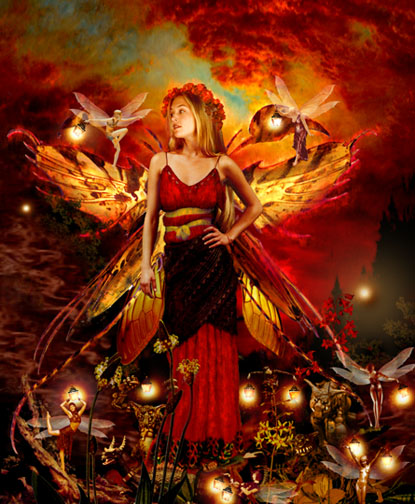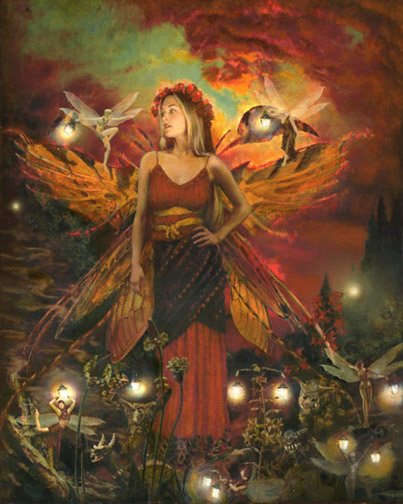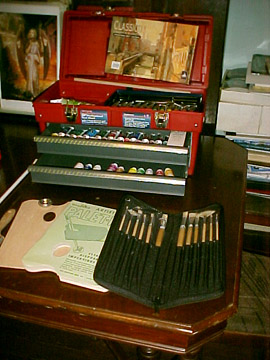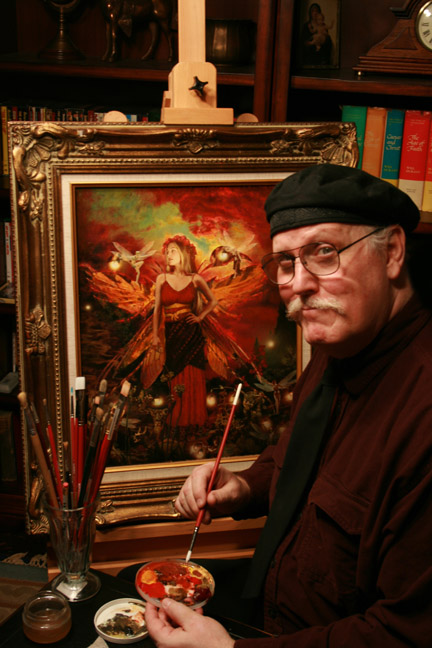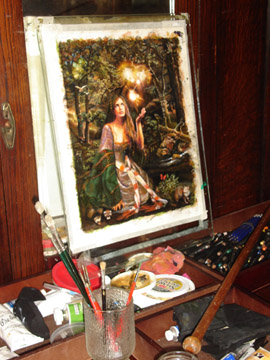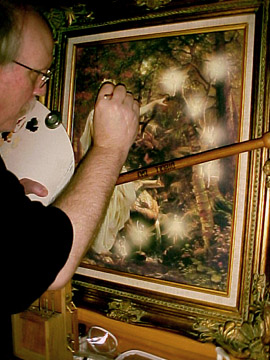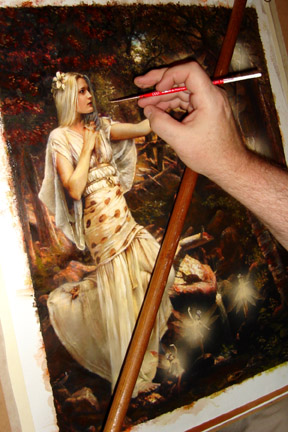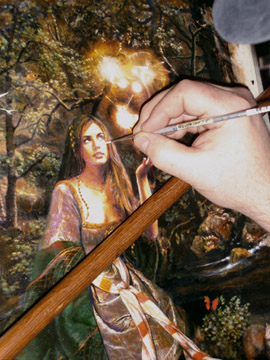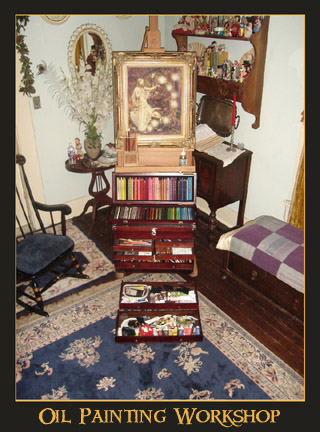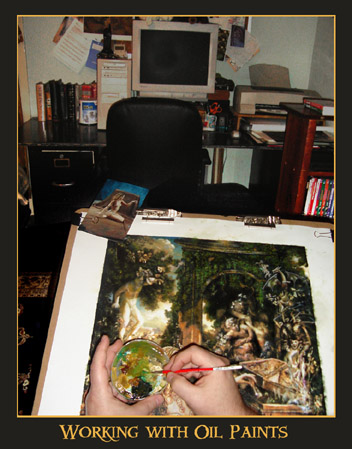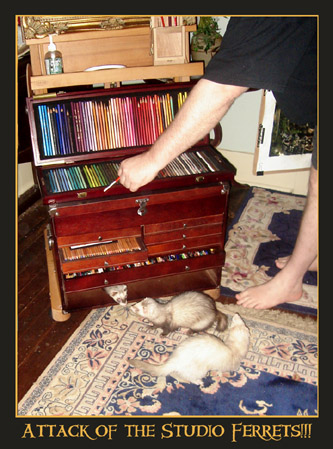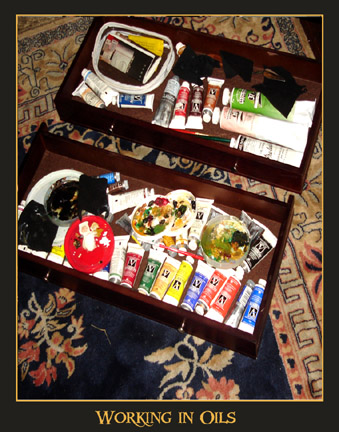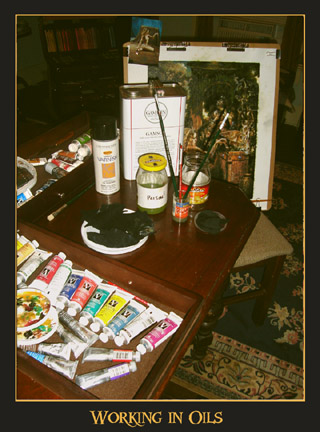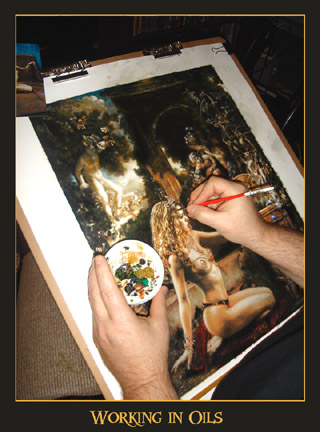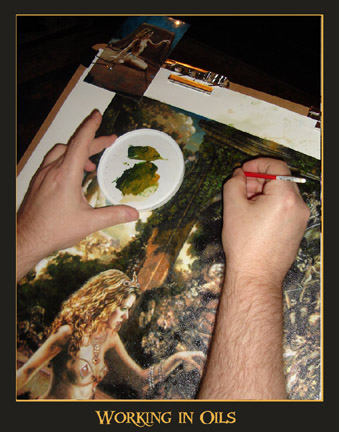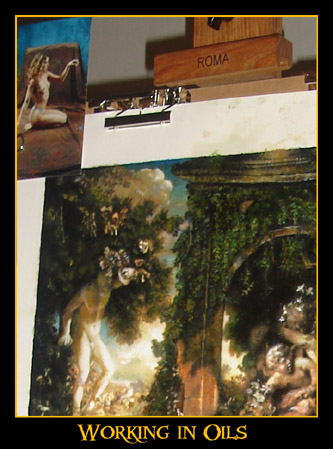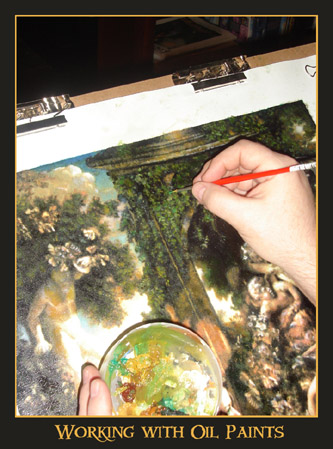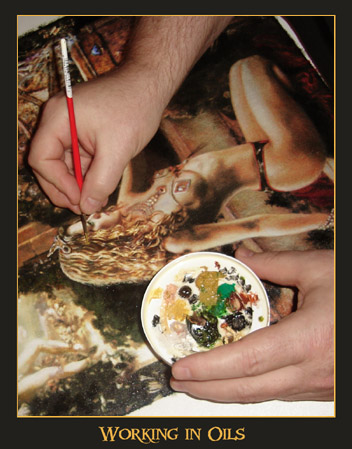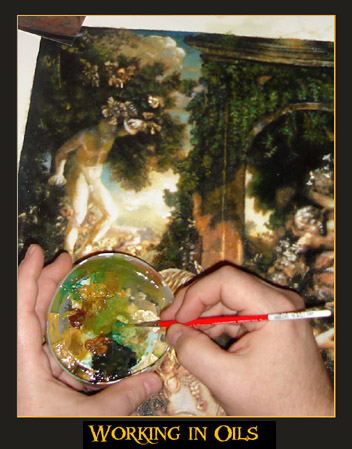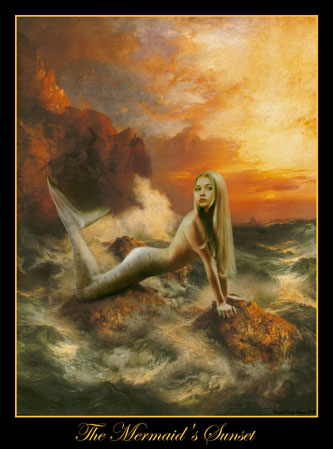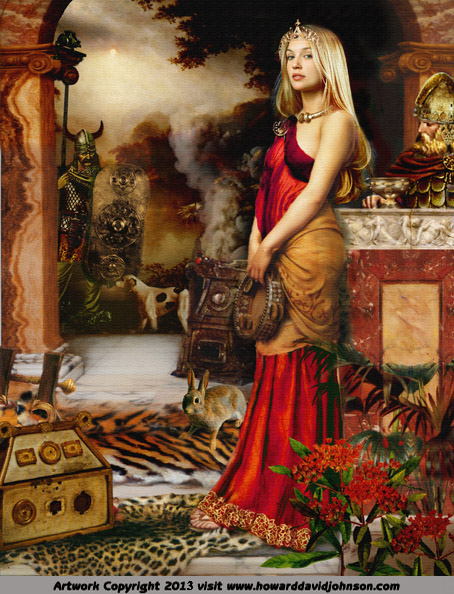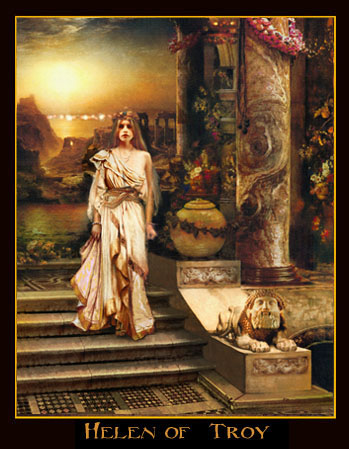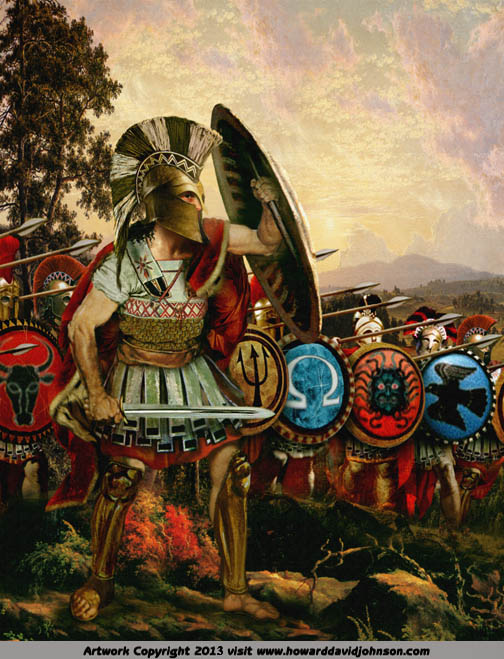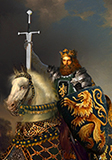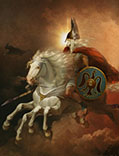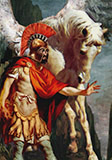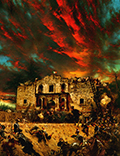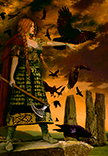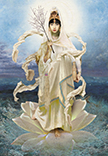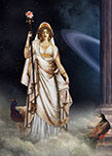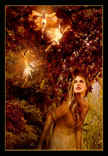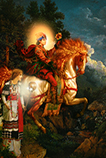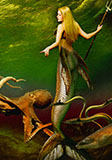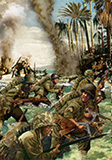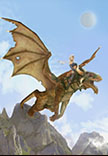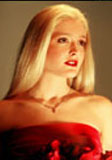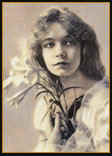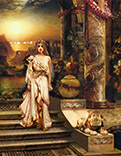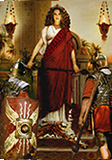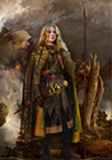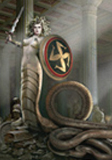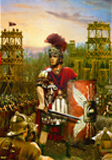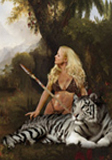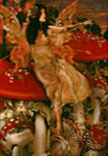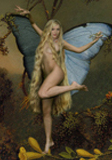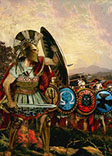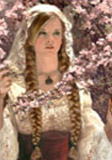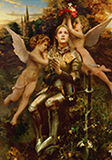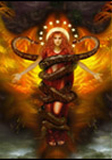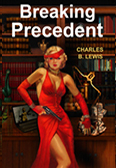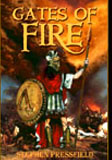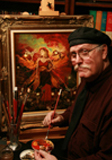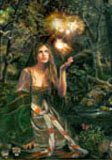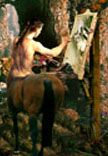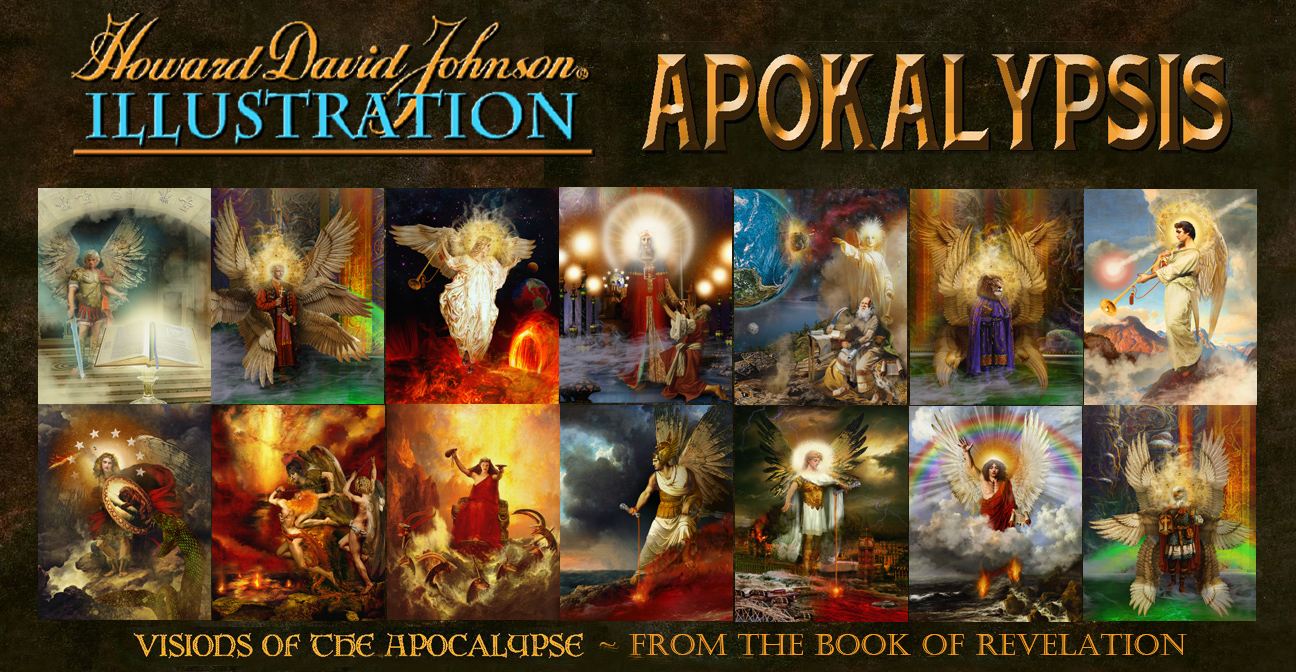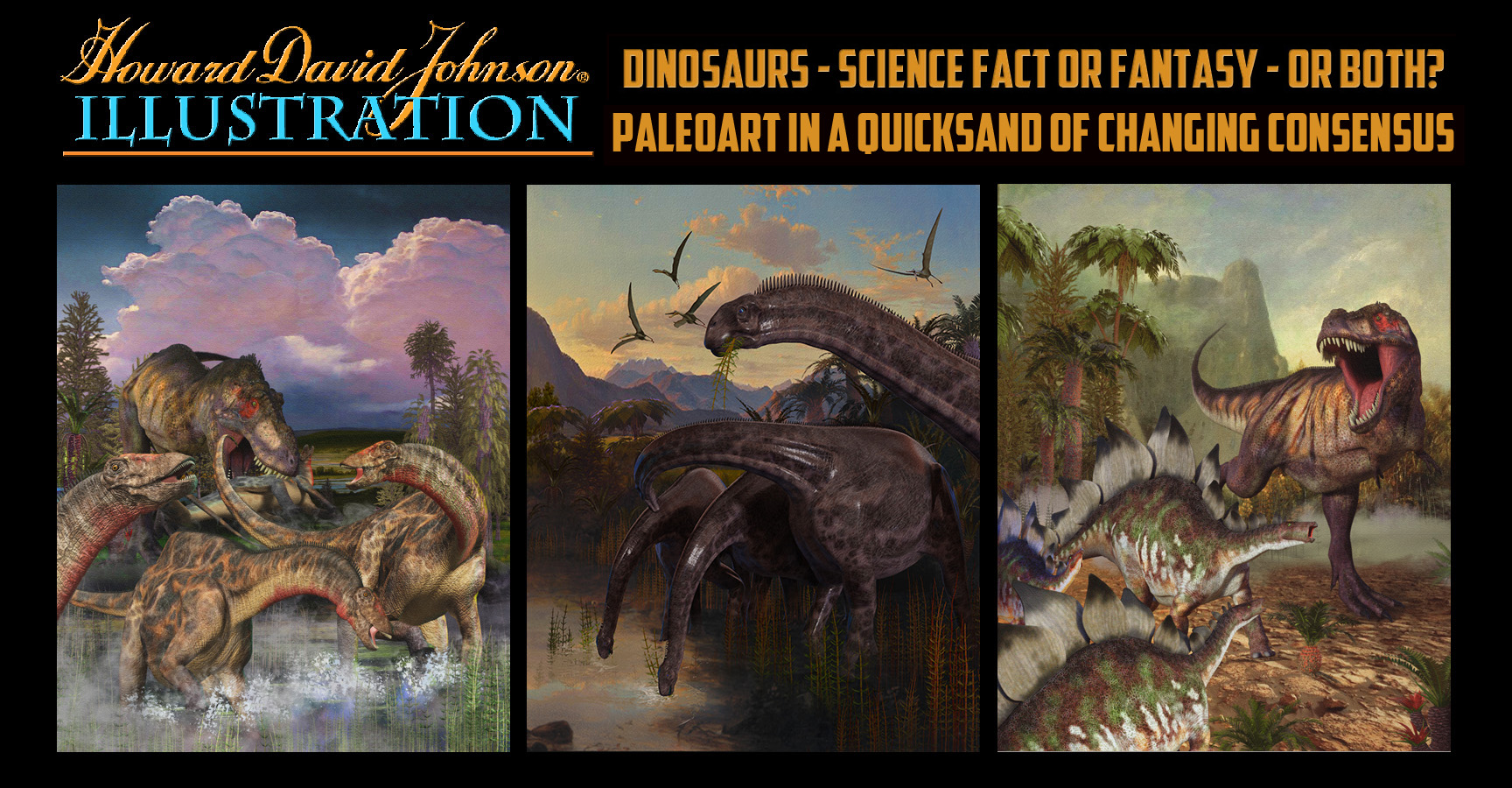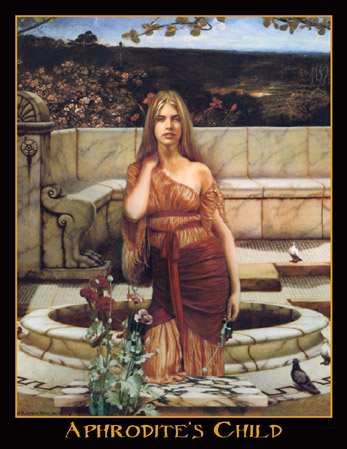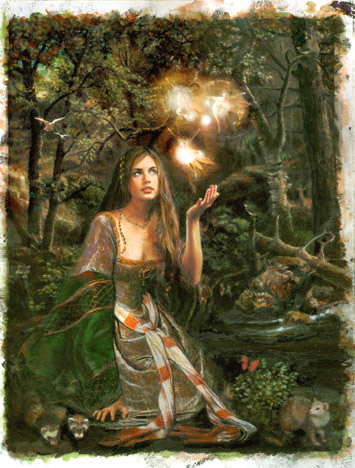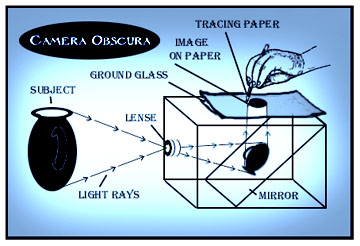|
Oil Paintings for sale; 21st Century Oils on Canvas: Portraits & Illustrations. Realistic Oil Paintings and a free lesson in oil painting technique by Howard David Johnson. An Exhibit of Realistic Oil Paintings featuring portraits & illustrations inspired by 19th Century Oil Paintings along with an introduction to Oil Painting Supplies, Organization & Technique with Essays with relevant themes to oil painters, painting & paintings yesterday and today.
"Athene, goddess of wisdom and justice" 20 x 16 oil painting on canvas and zoom in shot
Many pieces are now available, mostly 30 inch oil paintings on linen canvas with four inch mounting margin and also 16 x 20 inch oil paintings on cotton canvas Oil Paintings on canvas with four inch mounting margin. E-mail for current pricing.
~ also
11x14-13x16 inch Prismacolor Paintings and pencil portraits followed in
number by Acrylic, Prismacolor and pastel mixed media all on #400
Strathmore Bristol Board.
Nothing can compare to the quality of an original oil painting on
canvas! Pieces that
have never been rendered in oil can be commissioned in 16x20 inch size
on canvas for 50% down and delivered in under 90 days with signed
certificates of authenticity and legal documents pledging never to
render it in that size and media again to ensure premium collectability
and investment potential. If
you’ll tell me what kind of art you’re interested in it will be much
easier to tell what is currently available. These for sale items
include many kinds of media including illustrations and portraits. I
ship FEDEX worldwide in heavy duty protective packaging within 24 hours
of receiving payment.
I am open to discuss commissions in traditional and digital media. If I accept a project, I create a digital collage first to show you on the web, (its the modern version of the preliminary drawing,) then after it is approved, I copy your original art from it. I offer these for sale in 13 x 16 inch on Bristol Board or Cotman watercolour paper - mixed medias pieces including prismacolors and acrylics for $999. USD Ready in three weeks. I can also render them in oil on canvas. USD and have them ready in 90 days. I include a signed certificate of authenticity and a pledge not to do another in that size and media as per art etiquette and tradition. I send digital photos and updates to make the wait un-stressful. Payment is due fifty percent in advance the rest on satisfactory completion for commissions.
"Athene, goddess of Wisdom and Justice" 2008 Oil on 20 x 16 canvas (above right) is an example of Howard David Johnson's oil painting, referencing his original digital photo montage shown above left. He enthusiastically endorses Adobe Photoshop (TM) software for such preliminaries. David is currently accepting new oil commissions - rendering his existing other media art shown throughout his web in oils to add to his publishable inventory of oil paintings and because he can scan them and sell publishing licenses and thus earn money ongoing after sending you the only original...
Mixed Media Oil on Canvas "Queen Mab, the Bringer of Dreams" 2007 Oil on 20 x 16 canvas (above right) is another example of Howard David Johnson's oil painting. This photomontage preliminary method is the next logical step from the photo collage method employed by earlier artists like Maxfield Parrish... Of course David can oil paintings the old fashioned 16th century way but even starting at minimum wage, who can afford 30-60,000. USD these days?
Almost all of Johnson's Mixed Media creations (above left) displayed in this site are available to be rendered in oil on canvas like the 20x16 oil on canvas Faerie Guardians. Each design will only be rendered in oil once at this size and can be delivered in as little as 90 days.
Sadly, much of the subtlety, vibrance, lustre and impact of an original oil painting is lost when it is scanned and imported to digital media or even printed by a master printer. Nothing can compare to an original oil painting viewed in person in my opinion but the other painting media definitely look good in print and have their charms and distinct advantages as well. Here's more examples:
("Sleeping Beauty" MMV and "Pandora's Box" MMV
both rendered in traditional oil paints. Sleeping Beauty employs the
'wet on wet' technique and Pandora employs layers of transparent oil
glazes. What he's doing is
re-rendering his digital and prismacolor art into oil on canvas. He can
do this in 90 days and anything that has not already been done is
available for you to choose. We hope there is something on our site
you'd like to have rendered in oil as a one of a kind creation. These
three shown below for comparison are the same illustration in digital,
prismacolor and oil on canvas...
With a background in traditional media including oils, pastels & colored pencils, Howard David Johnson embraces leading edge digital media in the creation of his depictions of fantasy, folklore, mythology, legend, religion, and heroic history. He works in and mixes a wide variety of media * Oil paintings * Acrylic Paintings * Prismacolor Paintings * Drawings * Chalk & Oil Pastel Paintings * Photography * Digital Artistry & Mixed Media * Existing original oil paintings are for sale starting at 25,000.USD or new ones can be commissioned- E-mail for current pricing. Many pieces are now available, mostly 11x14-13x16 inch Prismacolor Paintings and pencil portraits followed in number by Acrylic, Prismacolor and pastel mixed media all on #400 Strathmore Bristol Board and Oil Paintings on canvas. Nothing can compare to the quality of an original oil painting on canvas! Pieces that have never been rendered in oil can be commissioned in 16x20 inch size on canvas for 50% down and delivered in under 90 days with signed certificates of authenticity and legal documents pledging never to render it in that size and media again to ensure premium collectability and investment potential.
He can also do a completely new picture designed in digital media (for more on this visit his digital media page) and when we approve the photo-montage, he uses it as reference to render it in oil on canvas. No surprises. Existing Artwork is shipped very well protected and go out to you immediately via Fed Ex or USPS Express mail upon receipt of payment at our expense. All new creations cost a bit more depending on what is involved. It is a LOT of fun with e-mail attachments and digital cameras. e-mail for more details at
|
||||||||||

Howard David Johnson's Tips on Oil Painting- tools and techniques
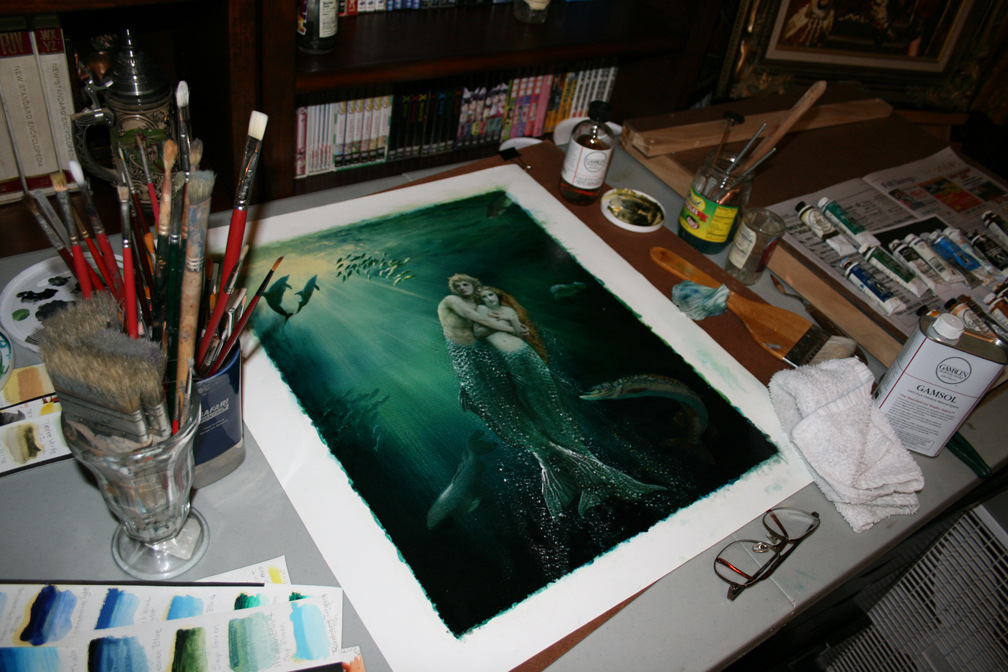
Free Previews of Art lessons:
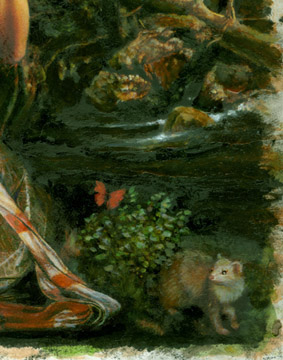
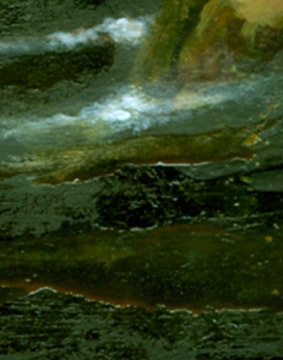
Sadly, much of the vibrance, lustre and impact of an original oil painting is lost when it is scanned and imported to digital media. Nothing can compare to an original oil painting in my opinion but the other painting media definitely have their charms and advantages as well.
Art Lessons: The Brandywine School of the Illustrative Arts offers beginning, intermediate, advanced & master level instruction in Drawing, Painting, Photography, & Digital Illustration with a personal touch by Internationally acclaimed Illustrator & portraitist Howard David Johnson. Beginning with 'Foundations For Art' at $199.00 U. S. D. (only $15 dollars per lesson for the 13 lesson course)- your lessons are delivered online immediately via e-mail and also mailed to you on CD-Rom Disk via U.S. P.S. Priority (2-3 day) mail. See Art Instruction for more info:
info@howarddavidjohnson.com
Thank you for Visiting... Your business, letters, & links are always welcome.
*****
SECTION TWO: STYLE and TECHNIQUE
| Howard David Johnson is a contemporary visual artist and photographer with a background in |
| the natural sciences and history. He works in a wide variety of media ranging from traditional |
| oils, pastels and others to cutting edge digital media. He loves mixing media. This site features |
|
examples of his Realistic Art, including illustration,
photography, experimentalism, and fine art.
|
|
Finding and training the right models is the hard part, then Photography, Mathematical Design and Digital Composition all come before the image is transferred to paper or canvas and rendered in mixed media ( including prismacolor pencils, oils, acrylics, and or many other traditional art media). |
The galleries linked to below show examples of His Realistic Paintings, and are grouped by theme rather than media. Since boyhood he has passionately copied the paintings of the old masters. He works in a wide variety of media ranging from traditional oils, pastels and others to today's digital media. After a lifetime of creating traditional drawings, acrylic and oil paintings, Howard David Johnson's Realistic Art was exhibited in the British Museum in London in 1996, (three years before he got his first computer ) as well as numerous American ones since, such as the Metropolitan Museum of Art. His illustrations have appeared in every major bookstore and gameshop chain in America as well as magazines and educational texts around the world. Some of his more prestigious clients have included the University of Texas, the Book of the Month Club, Paramount Studios, PBS TV, Adobe Photoshop Auto FX, and J Walter Thompson Advertising. Licenses to print his existing work are available at surprisingly affordable prices. To create his work, he usually starts with a thematic concept followed by a rough realistic pencil sketch, then followed by his photography, often traveling to find suitable scenes and locations and then working in his Photography studio with live models from his sketches. He then assembles a variety of elements which are realistic and original. As a boy he dedicated his life to art in 1960. From 1965- 1999 he used xeroxes and tracings to make his preliminary photo montages. |
||||
|
This method is patterned after the manner used by Maxfield Parrish and other 19th century notables. Beginning with a tracing, he then draws or paints from these complex original Computer Photo Montages. Many of these are on display on this web and slated for future completion in a variety of media for traditional realistic paintings and drawings. As this happens, the finished work is substituted in the exhibit. He has built up an enormous library of original source photos to use in his realistic paintings and drawings. Recently he shot hundreds of aerial photos of clouds at marvelous angles and perspectives & also looking down on the mighty mountains, rivers, & deserts of the American west while flying from Texas to Oregon & back for dynamic source material for realistic flying scenes in upcoming paintings, drawings, and pictures. For decades he has sought out the most beautiful models & brought them in for sessions in his photography studio. Using a strategy of J.W. Waterhouse, (The old master HDJ imitates most), his wistful & graceful models cannot be underestimated in their contribution to the stunning beauty & the potential for lasting appeal of his paintings. |
|||||
|
|||||
|
Art and Technology: From the Camera to the Computer A brief overview of the shifting cultural attitudes toward Realistic Art in the last 150 years ~Essay #8 by Howard David Johnson
The first decade of the 21st Century has seen a grass-roots counter-revolution in the art world which has overthrown the stranglehold elitist proponents of Abstract expressionism gained on academia, the media and the art world at large in the early 20th Century. Realistic Art was declared obsolete and irrelevant at the beginning of the 20th Century due to the easy chronicling of persons, places, and events by the Camera - in spite of this new technology empowering the greatest era in Realistic Art history. The “Modern Day Artist” refused to die and began to explore realms of the heart and mind the camera could not record. The proponents of Abstract Expressionism gained control of elite art collector’s markets followed by academic institutions and the media leading to the abandonment of centuries of classical teaching methods and traditions in our universities. Even the best realistic art was later denounced and ridiculed as the dismissive and often even hostile Art establishment created elitist scorn for Realistic Art in general. This created a disconnect with the general population who could not relate to the tenets of Abstract Expressionism. The advent of the internet broke the absolute domination of the opinions of the Abstract School on media and academia and opened the floodgates of artistic expression and free opinions. Free at last from institutionalized condemnation, more and more artists began to choose realistic treatments and a tidal wave of fabulous new realistic art has been created in every conceivable visual art media for museums, galleries, books, movies, and video games. As the camera became commercially available in the early 19th Century it became clear that the visual artist was no longer an indispensable member of society. Just about anyone could point and shoot this device at persons, places, and things and get very fast and very realistic results. Resentment from thousands of years of artists’ social and political influence fueled the notion that visual artists should be declared obsolete. The adoption of the camera as an artist’s tool and the advent of an era of glorious and unprecedented realism in painting did not stop the movement to crush the political and social influence of the artist. Great realistic artists like Pablo Picasso and others like Vincent Van Gogh courageously answered this challenge by exploring concepts that could not be photographed with brilliant and visionary works. It was from these honest and ingenious notions that the schools and sub-schools of Abstract Art developed. The freshness and innovation of this movement took the art world and academia by storm. The excitement of defining the tenets and the delight of bewildering the masses gave rise to an elite class of critics who could control the lucrative art collector’s market with obfuscation and intellectual snobbery. This wealthy art collector’s market gave credence to Abstract Expressionism’s “high art” status and the advice of well placed critics became extremely valuable and they formed an alliance with like-minded academics. As time passed, this trendy movement whose concepts were so hard to argue with gained control of the establishment and elitism took root. It was not long before traditional painting methods were not taught in universities any more as realistic art was no longer considered “Real Art” and tenets like; “Art must be ugly”, Art must be new” Art must be obscure”, and “The best Art is offensive” took hold in schools and printed media. Not satisfied with control over the most lucrative galleries, collector’s markets and academia, these elitists moved from dismissive to openly hostile attitudes toward those who still loved and created realistic art. The merciless and unprovoked rebukes of great realistic artists like Norman Rockwell, N.C. Wyeth and so many others are well documented in 20th century histories. That’s not “Real Art” and why do you waste your talent on “Mere Illustration” were some of the nicer comments. Illustrators in the 20th century wore these rebukes like badges of honor, like black eyes gained from standing up to schoolyard bullies, knowing in their hearts what they were doing was worthwhile and the narrow minded views of their critics were not the only valid opinions. By the end of the 20th century, the long apprenticeship tradition was broken and classical realistic art methods were lost forever. The Shock Art movement in the 1990’s carried the tenets to new extremes as “ART” became a dirty word. U.S. Government Endowments for the Arts were discontinued. Abstract Art had become the norm with its obfuscated themes and was then itself considered irrelevant and academically worthless. Art programs were then removed from countless public school curriculums to make time for standardized test preparation. There is no way that mandating more math, requiring more reading, or scheduling more science will replace what we have lost as a culture. At the turn of the 21st Century the Abstract Expressionists had been in control for generations with a thought control blockade in books, newspapers, radio, television and schools. Anyone who disagreed with them was told they were too stupid to understand “Real Art” and theirs was the only voice to be heard. What had begun so beautifully and sincerely was hijacked and violated until it became a byword for vulgarity. Then came the internet and the realistic artists, long silenced began to express their views. It was like the boy who cried: “The Emperor has no clothes!” This revelation spread like wildfire through the cultural consciousness. Suddenly, it was no longer a disgrace to hold something other than those narrow views. Galleries on the internet showcased generations of repressed artists realistic works in a tidal wave art history calls: “the Realistic Revolt”. Of course, Abstract Art still flourishes today especially on college campuses, but the narrow views of its most fanatical proponents are no longer cruelly dominant. The Realistic Revolt has brought the return of respectability to illustration and realistic landscape and portraiture. When I see the works of today’s vast multitude of realistic artists coming from a thousand different directions at once, tears come to my eyes, for I have worn the title “illustrator” as a badge of honor for decades and am deeply moved to have lived to see new developments in art and technology drive the visual arts to levels of quality beyond my wildest dreams. I predict 3D and digital media will grow more and more realistic until photos seem noticeably inferior. The internet has not only opened the floodgates for artistic expression, but employment and untold artists are earning a living shattering the “Starving Artist” stereotype so engrained in our cultural consciousness. The beginning of the 20th century saw technology threatening the survival of the professional artist and the end of it saw the unbridled tenets of Abstract Expressionism like “Art must be offensive” threatening the very existence of art as a part of our culture, the modern day artist has once again refused to die and has embraced technology to create a rebirth of realism that Art critics, collectors, academics and everyday folk can all embrace and celebrate in ways I once feared had been lost to us forever. ~ Howard David Johnson (2012)
|
Click Here for a Low Bandwidth Page with ALL Seven Essays by the Artist
|
REALISTIC ART: Personal Opinion Essays on Realistic Art yesterday and today by the artist. "Did you know the Greek word "Photography" means "Painting with Light"? Today with the advent of computers it truly lives up to it's name. Due to developments in Art and Technology combined with a general lack of public education, I contend that a more complete definition of the word "painting" is needed than that which is found in common usage."~ H D Johnson "Painting, in art, the action of laying colour on a surface, or the representation of objects by this means. Considered one of the fine arts" ~Encyclopaedia Britannica. "Painting. noun. 1.) The act or employment of laying on colors or paints. 2.) The art of forming figures or objects in colors on canvas or any other surface, or the art of representing to the eye by means of figures and colors any object; the work of an illustrator or painter. 3.) A picture; a likeness or resemblance in shape or colors. 4.) Colors laid on. 5.) Delineation that raises a vivid image in the mind; as in word painting. ~ Webster's Unabridged Dictionary of the English Language |
In addition to his mastery of traditional realistic art media, Howard David Johnson now combines drawing, painting, photography, and digital media with more than thirty years of experience in these fields to create his Realistic Art in 21st century paintings and pictures. He later renders the best of these again on paper and canvas in traditional media. Introducing ' Art Numérica'-an exciting merger of traditional visual art and cutting edge technology...
a new art form for the twenty- first century... this new Art media is not limited to realistic art but also offers limitless horizons for everything from cartoons to abstractions. It is the most dramatic development in the history of visual art since the Renaissance. In the words of Al Jolson in the movie world's first talking picture" You ain't seen nothin' yet!"
|
What is YOUR definition of ART? Essay one: On Realistic Art: THE MORE THINGS CHANGE, THE MORE THEY STAY THE SAME... ( A Brief essay dealing with attitudes toward Realistic Art and prior developments in technology in history) |
|
("Sleeping Beauty" MMV is an oil painting on bristol board.) |
Snobbism in the arts is nothing new. Some people will tell you that oils are the only valid medium for realistic paintings. That Colored Pencil, Digital, and other Realistic Painting and Drawing Media are not valid for "real" art. Young artists, Don't let them bother you. Their forerunners used to condemn Pastels before they gained acceptance and called them "crayons" when Johann Alexander Thiele (1685-1752) invented them. Mercilessly disrespectful art critics of the time could not stop the Experimentalists no matter how viciously they attacked and derided them. "Crayon-painting" as it was called in England was practiced early on by persecuted pioneers in Switzerland and many other nations. What a debt we owe to these master artists who refused to knuckle under to the pressure of those short-sighted critics during those historic and experimental times. It took until 1870 with the founding of the "Societe` Des Pastellistes" in France that respect came at last to these heroic & immortal visual artists. |
|
In England the liberation of the Pastellists from slight regard and undeserved disrespect came with the first exhibition of "The Pastel Society" at the Grosvenor Gallery in 1880. Pastel Painters like Mary Cassat and others from America and other nations forever silenced the snobs with their masterworks and gained recognition at long last for Thiele's invention as a valid art medium. I am persuaded that history will repeat itself. Like Pastels, I believe these wonderful new colored pencils and even Digital Realistic Art Media will one day receive the recognition they deserve as powerful mediums of artistic expression just as pastel paintings did. What is your definition of art? Have you thought about it? Mine is: "anything that makes you feel or think." Consider dancing... it can be a little skip in the step or rise to the level of the incomparable Russian Ballet. Did you know that just the materials alone for a single oil painting cost up to a thousand dollars these days? Even paying the artist less than minimum wage no one but the super rich can afford them anymore. Something's got to give. Realistic paintings in oil have been highly prized for centuries and the appeal and following of realistic art is undiminished to this day. Oil paintings featuring Abstract Art and Realistic Art are generally the most treasured form of all the visual art media and with good reason. But snobbish art critics favoring abstract art have declared that realistic paintings, or illustrations are not art for a century. With so many representationalist paintings by so many immortal master artists hanging in the Louvre, the Hermitage, and the British Museum and others I think the disrespect for realistic illustrators that dominated the 20th century is academically ridiculous as well as vain and intolerant, insisting theirs is the only valid opinion. What is your definition of Art? I believe almost any form of human expression can be raised to the level of "high art" especially visual art and Realistic illustration... |
|
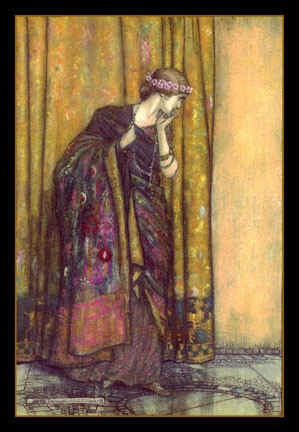
Pastel, Acrylics, and Colored Pencils combined |
By my own definition of art, which is:" anything that makes you feel or think" most abstract paintings are not "real art" to me personally, because abstract paintings usually neither make me feel or think, usually focusing obsessively on technique and avoiding any coherent content. I usually draw a complete blank mentally and emotionally when I look at them. In 1979 the Houston Metropolitan Museum of Art displayed a triptych of 3 giant paintings they paid fifty thousand dollars for- three blank white canvasses entitled" untitled". Then there was "The incredible new artistic Genius" with an I.Q. of 62 ...Congo the chimpanzee with his gala New York art exhibition...an elaborate prank played on the Snobbish American Art critics about a generation ago by research scientists in the field of primatology. Imagine how upset they were when he created one of his "ingenious masterpieces" right before their eyes. ( My Source for this is the Time Life Science Library volume entitled "The Primates". ) |
|
Art education has been almost completely removed from American Schools as a result of generations of this kind of fabulous nonsense contributing to America's cultural illiteracy crisis. Now, the works of Leonardo Da Vinci, Michelangelo, and other notables are being removed from school libraries. After generations of this, most American college graduates today cannot name even one living visual artist, abstract or realistic. There is no way that mandating more math, requiring more reading, or scheduling more science will replace what we have lost as a culture. ~HDJ ***** What is your definition of Art? |
|
|
Mechanical Aids: Are they right or wrong? Did you know the old masters often traced? Leonardo Da Vinci used "Camera Obscura" which is a lens and a mirror set at an angle with parchment over it to trace onto. Michaelangelo used a similar technique. Great Realistic Painters began employing photography as a mechanical aid immediately after it's invention in the 1800's. This is not surprising since artists had been tracing from Camera Obscura for thousands of years. Famous Myths; Leonardo Da Vinci (1452- 1519 ) is often credited with the invention of Camera Obscura because he used it for his masterworks during the Renaissance and mentioned it in his notebooks, but this is simply not true. Similarly, Americans are credited with the camera, but it is also not true. Unlike the camera, the inventor and time of invention of Camera Obscura are unknown. Perhaps it was known to the ancient Greeks, but there is no evidence for this. The mathematical precision and perfect anatomy of Greek art is enough evidence to convince many scholars. The earliest description of Camera Obscura occurs in the great optical treatise Opticae Thesaurus ( Book of optics ) of the Islamic scientist Al-Hazen who died at Cairo, Egypt in A.D. 1098. Since he says he did not invent it, we know it came sooner. On Copying and Copyright law in the Computer Age
|
|||
|
Over
the last 300 years, ideas about female beauty have drastically changed
and this has caused many of the most wonderful oil paintings of the old
masters to seem 'ugly' to youthful modern audiences. In the days of
Peter Paul Rubens, being forty to sixty pounds over-weight was
considered not only attractive, but was a status symbol. Beauty is in
the eye of the beholder and tastes have clearly changed.
These new oil paintings of mine take their inspiration in part from the oil paintings of the old masters just as The Lord of the Rings comes from The Ring of the Nibelung and European folklore, West Side Story came from Romeo and Juliet, which was in turn inspired by Antony and Cleopatra. Our shared cultural heritage, great works of art, literature, music and drama, cinema, folk tales and fairy tales are all drawn upon again and again by the creators of new works. These works in the public domain are both a catalyst and a wellspring for creativity and innovation. Even though all my Paintings in oil or other media are legally new works and protected under copyright law their inspiration sometimes comes in part from works in the public domain. The public domain is a space where intellectual property protection (copyright) does not apply. |
|||
|
|
When copyrights and patents expire, innovations and creative works fall
into the public domain. They may then be used by anyone without
permission and without the payment of a licensing fee. My sources have
been transformed so much in the creation of these new works of art that
they would not violate an existing copyright even if they were so
protected. Publicly owned national parks are also considered by many to
be public domain lands. Because of the recent extensions of the terms
of both copyrights and patents, and the privatization of lands and
other resources owned by the Federal Government, little is now entering
the public domain. Look for new litigation and another time extension
when Disney Corporation's Mickey Mouse copyright is due to expire in
2023.
Where would Walt Disney be without the Brothers Grimm, Hans Christian Anderson, or Victor Hugo? Where would Aaron Copeland have been without American folk music? Thomas Nast's Santa Claus without traditional images of Father Christmas? Picasso without African art? These are artists who made names for themselves and even fortunes through Public Domain appropriation, one and all. |
||
|
Beethoven did "variations on a theme" with the works of Mozart for the same reasons I have done mine with Waterhouse- to learn and give homage to the artist who most inspired me. Since the public domain is a treasure trove of information and resources to be used by future generations, many advocates are concerned that its stagnation will make it more and more difficult for future generations to find creative inspiration. Art tradition and etiquette suggest the most influential should be mentioned at exhibits; these original new pieces shown in this exhibit take their inspiration in part from the oil paintings of Waterhouse, Alma-Tadema, Moreau, Bouguereau, Leighton, Ingres, Moore, Parrish, Rackham and others. They showcase some of my favorite models. Most of my sources are changed so much they are impossible to detect, but sometimes I make it obvious to pay homage. None of my works has ever so closely resembled its inspirational paintings so much as "Helen of Troy": a deliberately obvious tribute to my most beloved master- John William Waterhouse; and is patterned after his "Miriamne leaving the judgment seat of Herod" I chose this one for my tribute because it is so often overlooked. The interior chamber with it's domed ceiling, King Herod on his throne, the eight man judiciary council of the San Hedrin, the chains and handcuffs, the tablets of the law and many other details are missing and in their places many new things are added. |
|
||
|
|
In Helen of Troy, new elements include Grace as the model, her jewelry and gown ornaments, The perspective is completely different with the view of the sea going off into the distance, the bas relief carvings, the ivy urn, the sphinx head, the flowers, the new floor, and the polished marble columns. When all is said and done, only the stairs, the lion's body and the basic outline of the gown have not been changed beyond all recognition. My Helen of Troy: the face that launched a thousand ships; shows instead her seeing the approaching sea lights of her husband Spartan King Menelaus' amphibious invasion fleet. (From Homer's The Iliad )As a student of fine art, copying is a great way to learn and create fine art, but as a professional illustrator copyright laws make things very different... My art is divided into two groups; personal work partially copying the old masters and professional illustration applying these lessons to create totally original works. I start more often with a specific written request. This is the exact OPPOSITE approach to creating a realistic painting copying something that's there. Research comes first. |
||
When asked why I usually work from photos I like to re-tell Norman Rockwell's story about having to paint a chicken: He set it up on a stump in a barn and goes to painting. The chicken moves it's head. He moves it back. The chicken jumps down. He puts it back. He goes to paint. now the chicken decides to make a break for it... he chases it down clucking and screaming and puts it back. Now it knows he's going to have it for dinner and it goes completely berserk. The next day, he came in and set the chicken back, snapped it's picture, and the photo held nice and still." ~ Howard David Johnson
Thank You For Visiting Howard David Johnson's Gallery of oil Paintings...
|
|||
|
With a background in traditional media including oils, pastels & colored pencils, Howard David Johnson embraces leading edge digital media in the creation of his depictions of fantasy, folklore, mythology, legend, religion, and heroic history. He works in a wide variety of media * Oil paintings * Acrylic Paintings * Prismacolor Paintings * Drawings * Chalk & Oil Pastel Paintings * Photography * 2D &3D Digital Artistry & Mixed Media *
Who is American Illustrator Howard David Johnson?
In one of David's invitations to the Florence Biennale Contemporary Art Exhibition, (a partner in the United Nations' Dialog among Nations), UN Secretary General Kofi Anon wrote him: "Artists have a special role to play in the global struggle for peace. At their best, artists speak not only to people; they speak for them. Art is a weapon against ignorance and hatred and an agent of public awareness... Art opens new doors for learning, understanding, and peace among nations."
|
|
Howard David Johnson is a contemporary realistic artist and photographer with a background in the natural sciences and history. David works in a wide variety of mixed media ranging from oil on canvas to digital media. David's realistic illustrations have made appearances in every major bookstore and game shop chain in America as well as magazines and educational texts around the world. Some of David's more prestigious clients have included the
University of Texas, the Universities of Oxford and Cambridge in
England, The Australian Mint, The National Geographic Society,
Paramount Studios, Universal Studios, MGM Studios, Warner Brothers Home
Video, ABC/Disney, CBS TV, PBS TV, The History Channel, Enslow
Educational Publishers, Adobe Photoshop, Auto FX, Tree-Free Greeting,
Verizon wireless, Apple IPOD, Penguin, Doubleday (Now Random House),
Harlequin Top Historical Romances, and the History Book of the Month
Club, as well as appearing in periodical publications like Popular
Photography and the Wall Street Journal.
|
A Traditional style portrait of the artist. [Photo by his son Erich.] |
After a lifetime of drawing and painting, David's Traditional Art was exhibited in the British Museum in London in 1996, ( 3 years before he got his first computer ) as well as numerous American ones since, such as the Metropolitan Museum of Art.
Working in a variety of media David offers his customers a variety of options and more than three decades of experience. As an illustrator he has not only used the computer but has been involved in the development and marketing of software for Adobe Photoshop. Digital art, Colored pencils, Pastels, Mixed media, & also Oil Paintings can also be commissioned for select projects.Digital illustration projects start at $500.U.S. and group rates are available. David delivers custom made copyright free illustrations & old fashioned customer service when he does work-for-hire. To publish existing pieces of his realistic art, David sells licenses starting at only $99.USD.
|
|
|
Business and Retail Services: You can e-mail for more details at: Your business, letters and links are always welcome!
|
||||
| This Gallery has been honored by more than 35,000,000 Unique Visitors from the Four Corners of the Earth My Friends from around the world thus far :
England, Canada,
Scotland, Wales, Ireland,
Germany, France,
Monaco, Andorra, Italy, The Vatican
City State,
Greece, Macedonia, Cyprus, Turkey,
Belgium, Denmark,
The Faroe Islands, Greenland, Yugoslavia,
Macedonia, Croatia, The Czech Republic,
Bosnia, Herzegovina, Slovakia, Slovenia,
Luxembourg, Latvia, Estonia, Hungary, Bulgaria,
Lithuania, Poland, Austria, Romania,
Spain, The Russian Federation, Estonia,
Ukraine, Kazakhstan, Moldova, Malta,
Iceland, Finland, Norway, Netherlands,
Switzerland, Liechtenstein, Sweden, Portugal,
Albania, Armenia, Georgia, Slovak Republic,
Azerbaijan, Belarus, Kazakhstan, Gibraltar,
Israel, Palestinian Territories, Egypt,
Libya, Mali, Algeria, Niger, Saudi Arabia, If your home is not listed here please e-mail and tell us where you're from... Your business, letters and links are always welcome!
|
|
Gorgeous Quality Printing Hand Signed & Numbered Free Shipping Worldwide
|
LIMITED EDITION [of a maximum 1,000 prints per image] PRINT-ON-DEMAND Each inspected, hand signed and numbered by the artist! CHECK OUT FAST WITH PAYPAL!
thejohnsongalleries@gmail.com Sized to fit standard sized frames! ASK ABOUT GIFT CERTIFICATES
|

The Johnson Galleries prints these "in-house" with our new state of the art Epson 7890 oversize printer on Epson 200 year premium photo paper and canvas with Epson inks!
|
All these realistic paintings, pictures, & text are copyrighted & were registered with the Library of Congress in 2004 by the author, Howard David Johnson All rights reserved worldwide
*****
|
Essay Two : The Rebirth of Realism More thoughts on realistic art yesterday and today by the artist
|
Art History has entered a new era with the birth of Art Numérica, or digital art media in the 21st century. Artists never stop exploring with mediums. Artists have been developing techniques, experimenting with different tools since at least twenty- five thousand years ago, when the first artist picked up a charred stick and scratched a picture out on the wall of his cave. You'd think everything would have been tried by now, but it hasn't. Exploring new mediums this very day is just as exciting, just as full of freshness and newness as it ever was.
|
Pandora's Box- rendered in Prismacolor pencils is not at all what people think of when they hear the word 'drawing' |
The
creation of Realistic art has been the goal of most artists since the
dawn of civilization. Realistic art was the pride of ancient
Greece. The world's greatest museums are full of realistic art.
Realistic art WAS art until the advent of the abstract expressionist
movement in the twentieth century. The coming of the camera in the
nineteenth century changed realistic art forever. \
Suddenly, realistic art was not the only way to create realism in portraits and historical records. The work of the realistic artist was suddenly made into an expensive luxury. The political power of the realistic artist was broken and they were no longer an indispensable member of society. Hostility to the creators of realistic art goes back to ancient times and the jealousy of advisers to the Pharaohs and others who were not able to spend as much time with their rulers as their portraitists. |
|
Although with the aid of photographs, realistic art achieved levels of excellence undreamed of, the realistic art movement of the late nineteenth century was short. None of these people earning their living creating realistic paintings could compete with the speed and low cost of photographic portraiture. Determined to survive, great realistic artists like Pablo Picasso ingeniously turned inward and began to explore things that could not be photographed in a new school of art, abstract expressionism. The day of the fine art superstars had arrived. It was now largely just a hobby to abstract and realistic artists alike. Illustration, because of advances in printing technology enabled an elite few to earn a living with their realistic art. These illustrators working in realistic art media were condemned and ridiculed in much the same way Europe's great symphonic composers were condemned for working in motion pictures after fleeing the nazis during World War Two. The rift between realistic and abstract art grew wider and wider. The universities and key media usually sided with the abstract camp and derided anyone working in any realistic art media declaring boldly that realistic art was not "real" art. Immortal giants of realistic art such as Maxfield Parrish were mistreated their entire lives. They were accused of selling out for creating beautiful realistic paintings to earn a living. The attitude that the true artist must suffer and starve and die in poverty became a rule. There were the Abstract art superstars, the professional realistic illustrators, and the hobbyists who, although cut off from gainful employment and social influence still recognized their artistic gifts as a calling rather than a profession. |
|
Early abstract art masters proved themselves as realistic artists before delving into realms of the intangible. They had to do this at that time to prove themselves because of the challenges they faced from the establishment for going against the status quo. In the latter part of the 20th century, realistic artists like HDJ were challenged to do abstract art to prove themselves as shown in the example above (Deirdre of the sorrows). Later realistic art training was abandoned in most schools and things like splattering paint in fits of rage were deemed more than enough. By the end of the 20th century something as destructive and ridiculous as nailing a pack of cigarettes to a shoe was considered fine art but not realistic paintings. Fashions in art have often been as silly as fashions in ladies hats. As the century drew to a close, many people had had enough. The realistic revolt was at hand. The rebirth of realism was fueled by the advent of the digital era. Now, for the first time in almost two centuries, an artist or illustrator could earn a decent living again with his realistic art. This is historic. Realistic art is not going to go away, especially now that photography has truly merged with traditional realistic visual art. Photography comes from the Greek words meaning "painting with light". Now with the advent of digital media the capability of realistic art has become almost limitless, truly, "painting with light". The merger of all the world's art forms to realize the potential of motion pictures has come now to still realistic art media. This website for example, on certain pages combines music, prose, poetry, photography and traditional realistic art media to create an experience beyond merely looking at realistic paintings.
The twenty- first century is already seeing a new renaissance in the arts because of the world wide web. There has never been anything like it. Abstract art, computer art, photographic art, and realistic art are continuing to be separate schools of art but are also blending to create exciting new horizons. Although Digital art does offer completely new horizons to the artist in the 21st century it does not mean the end of our time honored art traditions. Instead, it offers additional ways to keep these traditions and schools of thought fresh and alive.
~ HDJ
*****
On Realism and Mechanical Aids...
